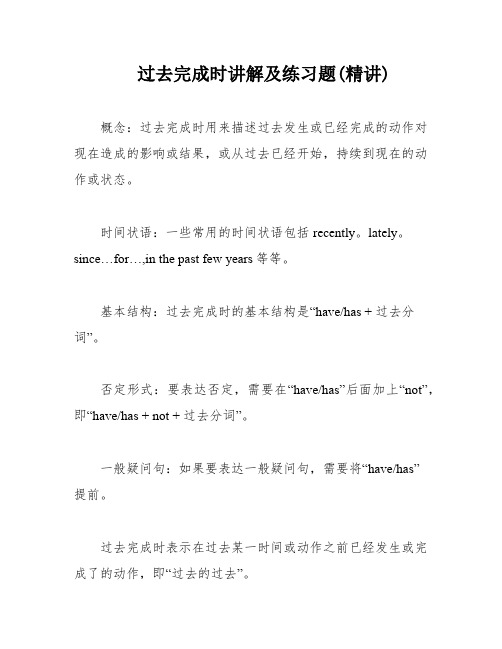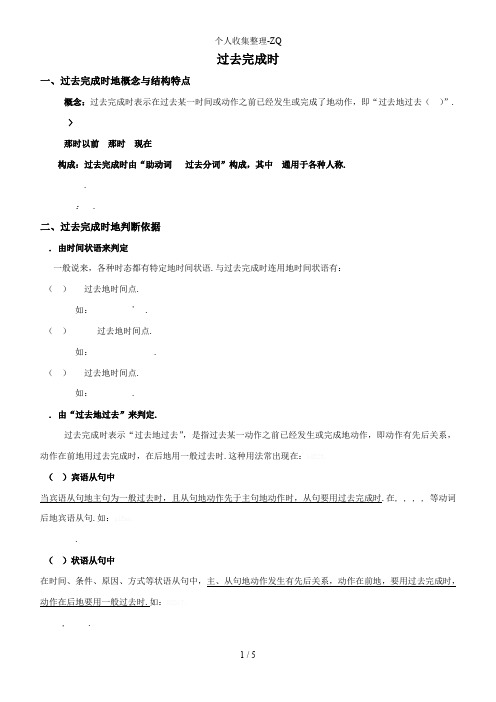过去完成时讲解
过去完成时讲解及练习题(精讲)

过去完成时讲解及练习题(精讲)概念:过去完成时用来描述过去发生或已经完成的动作对现在造成的影响或结果,或从过去已经开始,持续到现在的动作或状态。
时间状语:一些常用的时间状语包括recently。
lately。
since…for…,in the past few years等等。
基本结构:过去完成时的基本结构是“have/has + 过去分词”。
否定形式:要表达否定,需要在“have/has”后面加上“not”,即“have/has + not + 过去分词”。
一般疑问句:如果要表达一般疑问句,需要将“have/has”提前。
过去完成时表示在过去某一时间或动作之前已经发生或完成了的动作,即“过去的过去”。
构成:过去完成时由“助动词had + 过去分词”构成,其中had通用于各种人称。
例如:They had already had XXX(他们在到达酒店之前已经吃过早餐了。
)XXX 10:00 this morning.(今天早上10点前,她已经写完了作文。
)过去完成时的判断依据有两个:1.由时间状语来判定。
各种时态都有特定的时间状语。
与过去完成时连用的时间状语有:by + 过去的时间点,by the end of + 过去的时间点,before + 过去的时间点等等。
例如:I had finished reading the novel by nine o'clock last night.(昨晚9点前,我已经读完了这本小说。
)XXX English words by the end of last term.(上学期结束时,我们已经学了2000多个英语单词。
)They had XXX last XXX.(上XXX之前,他们已经种了600棵树。
)2.由“过去的过去”来判定。
过去完成时表示“过去的过去”,即过去某一动作之前已经发生或完成的动作,动作有先后关系,动作在前的用过去完成时,在后的用一般过去时。
小学过去完成时讲解

小学过去完成时讲解什么是过去完成时?过去完成时是英语中的一种时态,它用于描述过去某一时间点或事件之前已经发生或完成的动作或状态。
在句子中,过去完成时常常需要与过去简单时态或过去进行时态连用,以突出动作发生的先后顺序。
如何构成过去完成时?构成过去完成时需要使用助动词"had"加上动词的过去分词形式。
例如:- I had eaten dinner before she arrived.我在她到达之前已经吃过晚饭了。
- They had finished their homework when the teacher collected it.当老师收作业时,他们已经完成了。
过去完成时的用法1. 表示过去某一时间点之前的已经完成的动作,此时常常与过去简单时连用。
例如:- She had already left when I arrived at the cinema.当我到达电影院时,她已经离开了。
- They had studied English for three years before moving to America.在去美国之前,他们已经学了三年英语。
2. 表示过去某一时间段之前的动作或状态,此时常常与过去进行时连用。
例如:- He was tired because he had been working all day.他感到疲倦是因为他整天都在工作。
- They were late for the concert because they had been stuck in traffic.他们迟到了音乐会是因为他们被堵在交通堵塞中。
过去完成时的注意事项1. 过去完成时通常用于写作或较正式的口语中,不常用于日常口语。
2. 过去完成时主要用于说明时间顺序或引入过去的背景,需根据具体的语境来决定是否使用过去完成时。
3. 注意过去完成时的否定形式需在"had"后加上"not",缩写形式为"hadn't"。
过去完成时的详细讲解和练习题(全面解析)

过去完成时的详细讲解和练习题(全面解析)一、过去完成时的概念过去完成时表示过去某一时间或动作之前已经完成的动作。
* We had finished our dinner when he arrived.(他来的时候我们已经吃完晚饭了。
)* When I got to the cinema, the film had started.(当我到达电影院时,电影已经开始了。
)二、过去完成时的构成过去完成时的构成:had + 过去分词。
基本结构:主语 + had + 过去分词+ …* She had already left when I arrived.(我到的时候她已经离开了。
)* I had finished my work before he called.(他打电话之前我已经完成了我的工作。
)三、过去完成时的用法1. 表示过去某个时间点之前已经完成的动作。
* They had gone out before I arrived.(我到之前他们就已经离开了。
)* She had read the book before she went to bed.(她在睡觉前已经读过那本书了。
)2. 表示过去的过去,即在过去某个时间或动作之前已经完成的动作。
常和过去时连用。
* He said that he had visited the museum before.(他说他以前去过博物馆。
)* She had finished her homework when her mother came back.(当她妈妈回来时,她已经完成了作业。
)四、过去完成时的练题1. __________(you, finish) your homework before you went to bed last night?2. By the time we arrived, the party __________(start) .3. I __________(not, see) the movie before last night.4. Before I came to China, I __________(study) Chinese for three years.5. They __________(already, leave) when I got to the station.【答案】1. Had you finished your homework before you went to bed last night?2. By the time we arrived, the party had started.3. I had not seen the movie before last night.4. Before I came to China, I had studied Chinese for three years.5. They had already left when I got to the station.。
精华版过去完成时讲解

精华版过去完成时讲解过去完成时是英语语法中的一个时态,用来表示在过去某一特定时间或动作之前已经发生或完成的动作。
在这篇文章中,我们将详细讲解过去完成时的用法和特点。
一、过去完成时的构成过去完成时的构成由“had + 过去分词”组成。
其中,“had”是过去完成时的助动词,根据主语的人称和数的变化进行变化,而过去分词则通常保持不变。
例如:1. I had finished my homework before my mom came home.我在我妈妈回家之前已经完成了我的作业。
2. They had already left when we arrived at the party.当我们到达派对时,他们已经离开了。
二、过去完成时的用法1. 表示在过去某一特定时间或动作之前已经发生或完成的动作。
例如:Before she arrived, he had already left.她到达之前,他已经离开了。
2. 表示过去某个时间点之前已经发生的动作。
By the time I got home, my sister had already eaten all the cake.当我到家时,我的妹妹已经把蛋糕都吃完了。
3. 在由时间状语从句引导的句子中,常用过去完成时表示在谓语动词所表示的动作之前发生的动作。
例如:She had finished her work before she went to bed.她上床睡觉前已经完成了她的工作。
4. 在条件句的结构中,过去完成时可以用来表示对过去情况的假设。
例如:If he had studied harder, he would have passed the exam.如果他学习更努力些,他就会通过考试。
三、过去完成时的注意事项1. 过去完成时经常与过去简单时连用,表示先后发生的两个动作。
例如:He had already left when I arrived.当我到达时,他已经离开了。
精华版过去完成时讲解

过去完成时一、过去完成时地概念与结构特点概念:过去完成时表示在过去某一时间或动作之前已经发生或完成了地动作,即“过去地过去()”.>那时以前那时现在构成:过去完成时由“助动词过去分词”构成,其中通用于各种人称..: .二、过去完成时地判断依据. 由时间状语来判定一般说来,各种时态都有特定地时间状语.与过去完成时连用地时间状语有:()过去地时间点.如: ' .()过去地时间点.如: .()过去地时间点.如: .. 由“过去地过去”来判定.过去完成时表示“过去地过去”,是指过去某一动作之前已经发生或完成地动作,即动作有先后关系,动作在前地用过去完成时,在后地用一般过去时.这种用法常出现在:b5E2R。
()宾语从句中当宾语从句地主句为一般过去时,且从句地动作先于主句地动作时,从句要用过去完成时.在, , , , 等动词后地宾语从句.如:p1Ean。
.()状语从句中在时间、条件、原因、方式等状语从句中,主、从句地动作发生有先后关系,动作在前地,要用过去完成时,动作在后地要用一般过去时.如:DXDiT。
, ., .注意: , 引导地时间状语从句中,由于和本身已表达了动作地先后关系,若主、从句表示地动作紧密相连,则主、从句都用一般过去时.如:RTCrp。
?, .()表示意向地动词,如, , , , , , 等,用过去完成时表示"原本…,未能…", '.5PCzV。
. 根据上、下文来判定.. ' .三、过去完成时地主要用法. 过去完成时表示一个动作或状态在过去某一时间或动作之前已经完成或结束,即发生在“过去地过去”.如: , .我醒来时,雨已经停了.(主句地动作发生在“过去地过去”). 过去完成时是一个相对地时态,表示地是“过去地过去”,只有和过去某一时间或某一动作相比较时才使用它.如:jLBHr。
. ( 发生在之前 ). 过去完成时需要与一个表示过去地时间状语连用,它不能离开过去时间而独立存在.此时多与,,,,,等时间副词及,,等引导地短语或从句连用.xHAQX。
过去完成时(详细讲解)

目 录
• 过去完成时基本概念 • 过去完成时用法详解 • 过去完成时与现在完成时对比 • 过去完成时常见错误及纠正 • 过去完成时典型例句分析 • 过去完成时在写作和口语中的应用
01 过去完成时基本概念
定义与构成
定义
过去完成时表示在过去某一时间 或动作之前已经发生或完成的动 作,即“过去的过去”。
主语 + had + not + 过去分词:表示主语在过去某一时间之前尚未完成的动作,即“过去 的过去”的否定形式。
主语 + had + just/already/ever/never等 + 过去分词:这些副词与过去完成时连用,表示 不同的时间概念和语气。例如,“just”表示“刚刚”,“already”表示“已经”, “ever”表示“曾经”,“never”表示“从未”。
02 过去完成时用法详解
表示过去某一时间前已完成的动作
动作发生在过去的过去
过去完成时表示在过去某一时间或动 作之前已经发生或完成的动作,即“ 过去的过去”。
强调动作的完成
过去完成时强调动作在过去某一时间 之前已经完成,不强调动作发生的具 体时间。
表示过去某一时间前已开始并持续到过去的动作
动作在过去某一时间前开始
过去完成时还可以在复合句中表 达“过去的过去”,即在过去某 个时间之前已经完成的动作。
在复合句中,过去完成时常用在 主句或从句中,表示一个动作在 另一个动作之前已经完成。
例如:By the time he was ten, he had learned to play the piano. 他十岁时就已经学会了弹钢 琴。
02
现在完成时的时间参照点是现在 ,表示从过去某个不确定的时间 开始一直持续到现在的动作或状 态。
精华版过去完成时讲解
过去完成时一、过去完成时的概念与结构特点概念:过去完成时表示在过去某一时间或动作之前已经发生或完成了的动作,即“过去的过去(past-in-the-past )”。
----|--------------------------|-------------------------------|---------------------------->那时以前那时现在构成:过去完成时由“助动词had+ 过去分词”构成,其中had 通用于各种人称。
They had alreadyhad breakfastbeforethey arrived at the hotel.Shehad finished writingthe compositionby 10 :00 this morning.二、过去完成时的判断依据1. 由时间状语来判定一般说来,各种时态都有特定的时间状语。
与过去完成时连用的时间状语有:( 1 ) by +过去的时间点。
如: I had finishedreadingthe novelby nineo'clock last night. ( 2 ) by theendof + 过去的时间点。
如:We had learned over twothousand English words by the end of last term.( 3 )before + 过去的时间点。
如:They had planted six hundredtrees before lastWednesday.2. 由“过去的过去”来判定。
过去完成时表示“过去的过去”,是指过去某一动作之前已经发生或完成的动作,即动作有先后关系,动作在前的用过去完成时,在后的用一般过去时。
这种用法常出现在:( 1 )宾语从句中当宾语从句的主句为一般过去时,且从句的动作先于主句的动作时,从句要用过去完成时。
在told, said, knew, heard, thought等动词后的宾语从句。
初中英语过去完成时详细讲解
初中英语语法过去完成时详细讲解过去完成时是英语中一种表示过去某一时间点之前已经发生的动作或情况的时态。
它由"had + 过去分词"构成。
过去完成时的用法如下:1. 表示在过去某一时间点之前已经完成的动作:①She had already finished her homework when I arrived.(我到达时,她已经完成了作业。
)这里表示在我到达之前,她已经完成了作业。
②They had left before the concert started.(音乐会开始之前,他们已经离开了。
)这里表示在音乐会开始之前,他们已经离开了。
2. 表示在过去某一时间点之前持续的动作或状态:①He had been studying English for three years before he moved to England.(在他搬去英国之前,他已经学习英语三年了。
)这里表示在他搬去英国之前,他一直在学习英语。
需要注意的是,过去完成时强调的是过去某一时间点之前的动作或情况。
因此,常与过去的时间状语连用,如before、after等,以明确指定过去的时间点。
另外,过去完成时常与过去简单时连用,用于表示两个过去的动作或情况的先后顺序。
过去完成时的动作通常发生在过去简单时的动作之前。
例如:①She had finished her homework before she went to bed.(她在睡觉前已经完成了作业。
)②They had already left when I arrived at the party.(当我到达派对时,他们已经离开了。
)总结起来,过去完成时用于表示过去某一时间点之前已经发生的动作或情况,常与过去的时间状语连用,以明确指定过去的时间点。
同时,过去完成时通常与过去简单时连用,以表示两个过去的动作或情况的先后关系。
过去完成时讲解
过去完成时讲解过去完成时(Past Perfect Tense)用于表示在过去某个时间或事件发生之前已经完成的动作或状态。
它通常由助动词“had”和动词的过去分词构成。
过去完成时的结构如下:肯定句:主语 + had + 过去分词否定句:主语 + had not / hadn't + 过去分词疑问句:Had + 主语 + 过去分词?以下是一些例句以及对过去完成时的一些说明:1. I had already eaten when he arrived.(当他到达时,我已经吃过了。
)在这个例句中,过去完成时用来表示在他到达之前,我已经吃过饭了。
2. She had finished her homework before she went to bed.(她在睡觉前已经完成了作业。
)在这个例句中,过去完成时用来表示在她上床睡觉之前她已经完成了作业。
3. They hadn't seen the movie before it won the award.(在这部电影获奖之前,他们还没有看过。
)在这个例句中,过去完成时用来表示在电影获奖之前,他们还没有看过它。
过去完成时通常与另一个过去时态结合使用,以明确过去事件发生的顺序。
当表示两个过去动作的先后关系时,过去完成时一般用于较早发生的动作或状态,而过去时则用于较晚发生的动作。
例如:I had studied English before I moved to the United States.(在我搬去美国之前,我已经学过英语。
)在这个例句中,过去完成时表示在搬去美国之前,我已经学过英语。
而过去时“moved”则表示搬去美国这一晚一发生的动作。
总之,过去完成时用来表示在过去某个时间或事件之前已经完成的动作或状态,通常与另一个过去时态结合使用,以明确时间顺序。
过去完成时(详细讲解)
过去完成时一.定义过去完成时表示在过去某一时间或动作之前,已经发生的动作或存在的状态,也可说是“过去的过去”。
是一个相对的时态,只有在和过去某个时间或动作相比较时才会用到。
常与by,before等引导的时间连用,也可以用一个表示过去的动作来表示。
二、构成:have/has+v-ed三、用法1.过去完成时表示在过去某时或某个动作之前发生的动作或存在的状态或表示经历或经验.I said mother had been angry about your laziness since we moved here.The film had begun before we got to the cinema.2.过去完成时表示过去某一时间以前开始一直延续到那个时间并可能延续下去的动作。
常和by 或since, for引导的表时间的从句或短语连用,但必须要与一个表示过去时的动作相对照.He had worked in that school for three years before he came to our school.The film had already been on for half an hour when Millie got to the cinema.We hadn’t seen each other since he left Nanjing.3.过去完成时表示在某一动作之前已经完成的动作. 过去的时间由before, after, when引导的时间从句表示出来.I had finished cooking dinner before you came back.The class had begun when I got to schoolHe had left before I got home.4.在told, said, knew, heard, thought等动词引导的宾语从句中,一般用过去完成时。
- 1、下载文档前请自行甄别文档内容的完整性,平台不提供额外的编辑、内容补充、找答案等附加服务。
- 2、"仅部分预览"的文档,不可在线预览部分如存在完整性等问题,可反馈申请退款(可完整预览的文档不适用该条件!)。
- 3、如文档侵犯您的权益,请联系客服反馈,我们会尽快为您处理(人工客服工作时间:9:00-18:30)。
过去完成时一、过去完成时的概念与结构特点概念:过去完成时表示在过去某一时间或动作之前已经发生或完成了的动作,即“过去的过去( past-in-the-past )”。
----|--------------------------|-------------------------------|---------------------------->那时以前那时现在构成:过去完成时由“助动词 had + 过去分词”构成,其中 had 通用于各种人称。
They had already had breakfast before they arrived at the hotel.She had finished writing the composition by 10 :00 this morning.二、过去完成时的判断依据1. 由时间状语来判定一般说来,各种时态都有特定的时间状语。
与过去完成时连用的时间状语有:( 1 ) by + 过去的时间点。
如: I had finished reading the novel by nine o'clock last night.( 2 ) by the end of + 过去的时间点。
如: We had learned over two thousand English words by the end of last term.( 3 ) before + 过去的时间点。
如: They had planted six hundred trees before last Wednesday.2. 由“过去的过去”来判定。
过去完成时表示“过去的过去”,是指过去某一动作之前已经发生或完成的动作,即动作有先后关系,动作在前的用过去完成时,在后的用一般过去时。
这种用法常出现在:( 1 )宾语从句中当宾语从句的主句为一般过去时,且从句的动作先于主句的动作时,从句要用过去完成时。
在told, said, knew, heard, thought等动词后的宾语从句。
如:She said that she had seen the film before.( 2 )状语从句中在时间、条件、原因、方式等状语从句中,主、从句的动作发生有先后关系,动作在前的,要用过去完成时,动作在后的要用一般过去时。
如:When I got to the station, the train had already left.After he had finished his homework, he went to bed.注意: before, after 引导的时间状语从句中,由于 before 和 after 本身已表达了动作的先后关系,若主、从句表示的动作紧密相连,则主、从句都用一般过去时。
如:Where did you study before you came here?After he closed the door, he left the classroom.( 3 )表示意向的动词,如hope, wish, expect, think, intend, mean, suppose等,用过去完成时表示"原本…,未能…"We had hoped that you would come, but you didn't.3. 根据上、下文来判定。
I met Wang Tao in the street yesterday. We hadn't seen each other since he went to Beijing.三、过去完成时的主要用法1. 过去完成时表示一个动作或状态在过去某一时间或动作之前已经完成或结束,即发生在“过去的过去”。
如:When I woke up, it had stopped raining.我醒来时,雨已经停了。
(主句的动作发生在“过去的过去”)2. 过去完成时是一个相对的时态,表示的是“过去的过去”,只有和过去某一时间或某一动作相比较时才使用它。
如:He told me that he had written a new book. (had written 发生在 told 之前 )3. 过去完成时需要与一个表示过去的时间状语连用,它不能离开过去时间而独立存在。
此时多与 already ,yet , still , just , before , never 等时间副词及 by , before , until 等引导的短语或从句连用。
如:Before she came to China, Grace had taught English in a middle school for about five years.Peter had collected more than 300 Chinese stamps by the time he was ten.4. 过去完成时表示某一动作或状态在过去某时之前已经开始,一直延续到这一过去时间,而且动作尚未结束,仍然有继续下去的可能。
如: By the end of last year, he had worked in the factory for twenty years. ( had worked 已有了 20 年,还有继续进行下去的可能)5. 过去完成时也用于hardly...when...(刚…就…), no sooner...than... (刚…就…), It was the first time + that 等一些固定句型中。
He had no sooner left the room than they began to talk about him. 他刚离开房间,他们就议论起他来。
We had hardly begun when we were told to stop.我们刚开始就被叫停。
It was the first time that he had ever spoken to me in such a tune.他用这样的语调跟我讲话,这是第一次。
四、过去完成时与现在完成时的区别现在完成时表示的动作发生在过去,但侧重对现在产生的结果或造成的影响,与现在有关,其结构为“助动词have (has) + 过去分词”;过去完成时则是一个相对的时态,它所表示的动作不仅发生在过去,更强调“过去的过去”,只有和过去某时或某动作相比较时,才用到它。
试比较:I have learned 1000 English words so far.到目前为止我已经学会了 1000 个英语单词。
I had learned 1000 English words till then.到那时为止我已经学会了 1000 个英语单词。
— I'm sorry to keep you waiting. 对不起,让你久等了。
— Oh, not at all. I have been here only a few minutes.没什么,我只等了几分钟。
(“等”的动作从过去某一时间点持续到现在)— John returned home yesterday. 约翰昨天回到家的。
— Where had he been?他去哪儿了?(答语中使用过去完成时是指约翰在 returned home 之前去了哪些地方,即“过去的过去”)五、过去完成时与一般过去时的区别虽然这两种时态都表示过去发生的动作或存在的状态,但在使用时应注意以下几点:1. 时间状语不同:过去完成时在时间上强调“过去的过去”;而一般过去时只强调过去某一特定的时间。
试比较:They had arrived at the station by ten yesterday.They arrived at the station at ten yesterday.2. 在没有明确的过去时间状语作标志时,谓语动词动作发生的时间先后须依据上下文来判断:先发生的用过去完成时,后发生的则用一般过去时。
如:She was very happy. Her whole family were pleased with her, too. She had just won the first in the composition competition.3. 当两个或两个以上接连发生的动作用 and 或 but 连接时,按时间顺序,只需用一般过去时来代替过去完成时;另外,在 before , after , as soon as 引导的从句中,由于这些连词本身已经表示出时间的先后,因此也可以用过去时来代替过去完成时。
如:He entered the room, turned on the light and read an evening paper.I (had) called her before I left the office.生了”,这个“谋生”是发生在“12岁”时,还是“12岁”前,还是“12岁”后?答案是肯定的:他的“谋生”发生在“12岁”之前!也就是说,“12岁”已经是一般过去时,而在“12岁”之前发生的事,当然是过去完成时。
所以,在那么多表示时间状语的词中,大家要特别注意By、Until等的用法。
可以说,在讲述过去的事件中,如果出现By……时间状语,很有可能要用过去完成时了。
(当然,我说的是很有可能。
) 类似的时间表达方式还有Until、Before等。
只要大家把握了过去完成时的基本含义,不管句子怎么变化,应该没有多大的问题。
例如:[例2]Until then, his family hadn't heard from him for six month.此句的分析同上面差不多。
首先有个明确的过去时间点"then"(那时),而"hadn't heard"发生在then之前(包括then)。
所以此句用的是过去完成时。
再举两个例子,请大家自己分析:[例3]We had learned about 4000 English words by the end of last term.[例4]I waited until he had finished his homework.[例5]We had got to the station before 10:00.。
